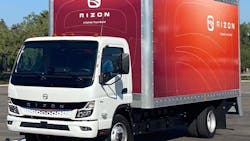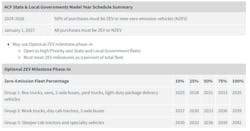Some small fleets lean into EV benefits as CARB rules loom
Electric vehicles come with their downsides: heavy batteries, longer "refuel" times, and less range than a tank of gas or diesel fuel. These downsides don't affect the average driver, but they make a world of difference for a fleet.
As EV truck engineers work to improve these aspects, fleets are learning how to implement these more restrictive vehicles into their operations, most prominently in California, where the Advanced Clean Fleets Regulation takes effect on January 1, 2024.
See also: How fleets can prep for California's Clean Truck Check program
CARB regulations taking effect in 2024
In the new year, fleets that perform drayage operations must register all vehicles in the CARB Online System to continue operating in California. Fleet vehicles that aren’t zero-emission must be registered in the system by Dec. 31. Fleets can operate these “legacy” vehicles through their “minimum useful life,” according to the regulation. Any new vehicle registered to the CARB system after Dec. 31 must be a ZEV. Additionally, “all drayage trucks entering seaports and intermodal railyards would be required to be zero-emission by 2035.”
The regulation also affects high-priority fleets beginning Jan. 1. CARB defines high-priority fleets as “entities that own, operate, or direct at least one vehicle in California, and that have either $50 million or more in gross annual revenues, or that own, operate, or have common ownership or control of a total of 50 or more vehicles (excluding light-duty package delivery vehicles).”
These fleets must comply with Model Year Schedules, meaning fleets can only purchase ZEVs in 2024 and must remove ICE vehicles from operations at the end of their useful life “as specified in the regulation” beginning in 2025. High-priority fleets can also forego the Model Year Schedule and use the ZEVMilestone Option. This option allows fleets to “meet ZEV targets as a percentage of the total fleet starting with vehicle types that are most suitable for electrification.”
State and local fleets will also be affected by the regulation. Beginning in 2024, these entities must ensure that 50% of their fleet vehicle purchases are ZEVs. Starting in 2027, 100% of fleet vehicle purchases must be ZEVs. These fleets can also opt to abide by the ZEVMilestone Option. Further, “state and local government fleets may purchase either ZEVs or near-ZEVs or a combination of ZEVs and near-ZEVs, until 2035. Starting in 2035, only ZEVs will meet the requirements.”
See also: CARB approves $624 million funding plan
Leaning into EVs
Some fleets are getting ahead of the regulations and implementing electric vehicles into their fleets now.
Martin Carmody is the co-owner of Eco Recycling, a northern California-based company that sells used books and clothing. He recently ordered three electric trucks for his fleet for multiple reasons, including the regulations.
"I knew (regulations were) coming down the road, and I wanted to get a head start on it and get my foot in the door," Carmody told FleetOwner.
Eco Recycling operates box trucks from early morning to later in the evening, picking up material from donation boxes across an 8-hour route until the truck is fully loaded—about 20 to 25 boxes, Carmody said. At that point, the operator will return to Eco Recycling's warehouse and empty the truck for other team members to sort through the 7,000 pounds of items picked up along the way.
Although Carmody's small business won't be affected by the new CARB regulations taking effect in 2024, current regulations, maintenance, and diesel fuel costs led Carmody to seek other powertrain options.
"We spent a lot of money on maintaining our diesel trucks," Carmody said. "Here in California, we have the CARB regulations … and there's all these special filters on all diesel trucks. And they're very expensive, and they are pretty sensitive—they break a lot. And we have all sorts of issues, downtime, while we're trying to fix them and spending lots of money on that."
Thanks to the California Hybrid and Zero-emission Truck and Bus Voucher Incentive Project, Carmody decided now was the perfect time to add EVs to his fleet.
"That's also a big reason why we decided to go EV because of those incentives," Carmody said.
See also: Incentives worth tens of thousands unlock EV affordability
Eco Recycling chooses incentive-eligible medium-duty EV
Carmody's EV of choice was the Rizon 18L, a medium-duty EV cabover designed by Daimler Truck. The Rizon is available in Class 4 and Class 5 with two configurations for each class: e16M, e16L, e18M, and e18L. The M Rizon trucks feature two battery packs with 72 kWh of usable energy and a range of 70 to 110 miles. The L Rizon trucks feature three battery packs with 116 kWh of usable energy and a range of 110 to 160 miles on one charge. The powertrain offers 173 horsepower and 317 lb.-ft. of torque. Additionally, the Rizon offers both AC and DC charging connections for overnight or quick recharging.
Although these three Rizon trucks will be the first in Carmody's fleet, they weren't the first he ordered. He previously ordered EVs from another manufacturer but canceled that order to purchase the Rizon trucks instead.
See also: First of Daimler's new medium-duty EV trucks reach U.S. shores
He decided to go with Rizon because he was impressed that the trucks were backed by Daimler Truck, the price of the trucks was more appealing, and he could test drive the Rizon at a show—unlike the trucks he previously ordered. But more importantly to Carmody, the folks at Rizon could answer more of his questions concerning vehicle weight, range, and what incentives Eco Recycling was eligible for.
"They weren't clear. They didn't know," Carmody said about the OEM that manufactured the first trucks he ordered and its knowledge of EV incentives. As for the folks at Rizon, Carmody said he asked them about incentive eligibility, and—because they hired a third-party company to help small fleets and OEMs make sense of EV incentives and funding—he got answers to his questions.
The Rizon is eligible for a base voucher of $60,000 per vehicle through the HVIP, and because Eco Recycling is a small business, it was eligible to receive double that amount.
Because of the nature of Eco Recycling's truck operations—working during the day and parking the trucks at night—Carmody doesn't anticipate the need to install Level 3 DC fast chargers in the Eco Recycling facility. He'll install simple 220V wall chargers, which Rizon said will be sufficient for the trucks' charging needs.
Although Carmody expects to receive his first three electric fleet vehicles in February, he's hopeful that EV manufacturers will continue developing the batteries so that range is increased and he can one day run a fully electrified fleet.
About the Author
Jade Brasher
Senior Editor Jade Brasher has covered vocational trucking and fleets since 2018. A graduate of The University of Alabama with a degree in journalism, Jade enjoys telling stories about the people behind the wheel and the intricate processes of the ever-evolving trucking industry.


